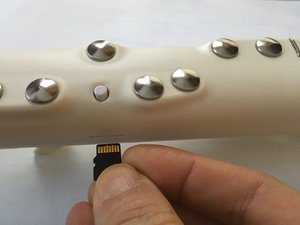SD Card Usage
The Vindor ES1 can use an SD Card to play samples for notes. The sound files can be generated with most DAWs or sound editing software.
Summary
- Hardware: MicroSD Class 10 speed or better.
- SD format supported: FAT, FAT32, ExFAT. Almost all SD card come preformatted in one of these formats. The Vindor does not work with specialty formats like NTFS and APFS.
- Sound file format:
- Type: WAV
- Rate: 44100 samples per second (CD quality)
- Bits: 16-bit mono.
- Compression: Uncompressed
- The directory structure is:
- /vindor —> all files are located in this directory
- /vindor/s# —> “#” is replaced with the instrument number, as in “s4”, “s5”, etc.
- /vindor/s#/play.inf —> describes the looping (if any) of each file.
- /vindor/s#/play##.wav —> “##” is the MIDI note number (where C4 is 60).
SAMPLE DOWNLOADS
We provide disk images that you can download and copy to an SD card.
- [ Download ]: Violin, Trumpet, Oboe, Sax, Clarinet, Flute
- [ Download ]: Harmonica, Accordion, Choir, Glass, Pipe Organ, Rock Organ
The easiest way to get started is to download one of these images and copy all the files to your SD card.
INSERTING THE SD CARD

The SD card is inserted so that the metal contacts point to the top of the instrument. If you attempt to insert it upside down it will not work.
SD CARD FORMAT
Most SD cards come pre-formatted in a compatible format. But if you need to reformat the card, follow the instructions in our SD Card Format page.
SOUND FILE FORMAT
Each note should have it’s own sound file. The file name is the MIDI note number followed by the extension. For example, A above middle C (A4) is note number 69. Thus, the file name would be “69.wav”.
Sound files must be converted so the Vindor can process them efficiently. The required format is a WAV file, 44100 samples per second, 16-bit mono, uncompressed. Most DAWs and sound processing tools should support this format. If you need help on a specific tool, please contact support, but keep in mind that there are thousands of tools and we have familiarity with only a few of them.
FORMAT OF PLAY.INF
The “play.inf” file describes each individual sound file so the Vindor knows where to start, end and loop.
The file begins with a short text with the name of the instrument:
disp=Trumpet
Following this line is one line for every MIDI note from 24 to 101 describing the looping to perform if the note sustains for longer than the length of the sample file. The format is the note number, a comma, the sample number for the loop start, a comma, and the sample number for the loop end. For example:
60,33553,40881
In the above case, note number 60 (which is middle C, or C4) will play up to sample number 40881 and then loop back to sample 33553. This looping will continue until the note is released. The Vindor will play file “play60.wav”.
If you don’t want any looping, don’t include a line in the file. If your sounds file lasts for more than 8 seconds, which is longer than most people can blow, then looping is generally not needed.
